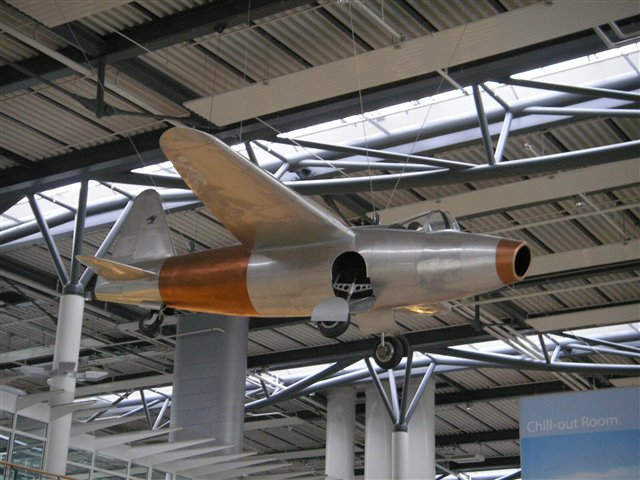On this day in (engineering) history…
August 27, 1939 - First flight of the Heinkel He. 178
An odd sight would have greeted anyone seeing today’s routine test flight at the Heinkel aircraft company’s Marienehe airfield in Rostock, Germany. The aircraft made a noise resembling a whistling howl. It had a strange opening at its nose and no visible means of propulsion. What the gathered company designers and engineers were studying closely, was the first flight of a turbojet-powered aircraft – the jet age has just arrived.
Take off

Replica of Heinkel He. 178 in the arrival hall of Rostock-Laage airport. Source: Wikimedia Commons
The pilot was Erich Warsitz, who had already test-flown an experimental rocket-powered plane, the Heinkel He. 176 two months earlier. He wrote:
“…As the aircraft began to roll, I was initially rather disappointed at the thrust, for she did not shoot forward as the 176 (rocket-powered aircraft) had done but moved off slowly. By the 300-meter mark, she was moving very fast. The 176 was much more spectacular, more agile, faster, and more dangerous. The 178, on the other hand, was more like a utility aircraft and resembled a conventional aircraft.”
Six years earlier, Hans Joachim Pabst von Ohain was a PhD student at the University of Gottingen when he developed an idea for jet propulsion. In 1936, shortly after receiving a patent for his design, Von Ohain presented his ideas to aircraft manufacturer Ernst Heinkel.
Heinkel was obsessed with speed and pushing aircraft ever faster. He agreed to fund development of a demonstration engine, which became the hydrogen-powered Heinkel HeS 1, bench-tested in September 1937. In 1939, the Heinkel He. 178 would be built around Von Ohain’s third engine, the diesel/gasoline-fueled HeS 3.
Hans Von Ohain, Chief Scientist of the Aero Propulsion Laboratory, Wright-Patterson Air Force Base, 1970s Source: Wikimedia Commons
Compressed air

“In this machine, I felt completely safe and had no worries that my fuel tanks would be dry within a minute. She was wonderfully easy to hold straight, and then she lifted off. Despite several attempts, I could not retract the undercarriage. It was not important, all that mattered was that she flew.”
Crudely put, the jet engine is based on forcing an airflow into a compressor, moving the compressed air into a combustion chamber where it is mixed with fuel, and venting the resulting exhaust through a cone at the back.
There were two basic types of gas turbine jet engine. The centrifugal engine compressor forces the airflow out from the centre to compress it before it is sent to the combustion chamber. Axial flow compressors push the air into a series of ever smaller chambers before it mixes with fuel in the combustion chamber. The gases are then expelled through the exhaust cone. Here, the air moves through the engine in a straight line.
Both types have their advantages and disadvantages. Axial engines provide more thrust and are more efficient, smaller, and lighter than centrifugal engines. Centrifugal engines are simpler and cheaper to build while requiring less maintenance.
Who got there first
“The rudder and all flaps worked almost normally, the turbine howled. It was glorious to fly, the morning was windless, the sun low on the horizon. My airspeed indicator registered 600 km/h, and that was the maximum Schwärzler had warned me. Therefore, I throttled back, since I habitually accepted the advice of experienced aeronautical engineers. The tanks were not full and, contrary to custom, I did not want to gain altitude for a parachute jump should things go awry.”
Von Ohain was not the first to develop a turbojet. He was luckier than the man credited with inventing the jet engine. The wildly adventurous pilot, mathematician and engineer Frank Whittle was thinking about turbojet-powered aircraft as far back as 1928. While his idea, an axial flow compressor coupled to a centrifugal compressor, was patented in 1930, he took the better part of a decade to get his idea into the air. Whittle’s problem was that he was trying to develop the new technology in the UK, which proved highly conservative, with little interest in supporting something so radical.
The engine that would power the Gloster E.28/39 (the first British jet, flew in 1941) - the Power Jets W. U. turbojet engine (Power Jets was Whittle’s company, ‘W. U.’ for ‘Whittle Unit’) was first bench-tested on April 12 1937 - was a more straightforward, centrifugal design.
“It was supposed to be a short flight. At 300 to 400 meters altitude, I banked cautiously left – rudder effect not quite normal, the machine hung to the left a little, but I held her easily with the control stick, she turned a little more, and everything looked good.”
Whilst Whittle may have been the first to pick up a patent for a machine that could be built using existing technology, his turbojet design was not the first. His work took in ideas from Alan Arnold Griffith, an engineer who worked on metal fatigue and improving the efficiency of aircraft engines. In 1926, Griffith published a highly influential paper, An Aerodynamic Theory of Turbine Design, which described an axial compressor and two-stage turbine. French engineer Maxime Guillaume received a French patent for an axial flow turbojet in 1922. This consisted of successive chambers compressing the airflow before it entered the combustion chamber. The main problem faced by Guillaume was that the idea, though correct, was far ahead of the technology of the day.
The plane, the plane
“After flying a wide circuit my orders were to land at once, this had been hammered into me, but now I felt the urge to go round again. I increased speed and thought, ‘Ach! I will!’ Below I could see the team waving at me.”

Heinkel He. 178. Possibly the unpowered V2 prototype, equipped with squared-off wings (which was photographed more often than the powered He 178 V1 prototype). Source: Wikimedia Commons
Other than the engine, everything about the Heinkel He. 178 was conventional and highly crafted. It featured wooden, asbestos-protected wings, shoulder mounted onto a duralumin, shell construction fuselage with a circular cross-section. The air intake was on the nose, while the exhaust pipe was under and slightly behind the rudder. It featured a conventional, retractable undercarriage with the tail wheel mounted beneath the aircraft’s tail section.
Making history as the first jet pilot that morning was Erich Karl Warsitz, an experienced test pilot. The plane’s fuel load was not great, with only ten minutes of endurance.
“On the second circuit – I had been in the air six minutes – I told myself ‘Finish off!’ and began the landing. The turbine obeyed my movement of the throttle even though a fuel pump had failed, as I knew from my instruments and later during the visual checks. Because the airfield was so small for such flights, I was a little worried about the landing because we did not know for certain the safe landing speed: we knew the right approach, gliding and landing speeds in theory, but not in practice, and they did not always coincide.”
The Heinkel 178, like all such technology testers, had shortcomings. Among them, the lack of endurance and a relatively weak engine limiting its speed to 372mph (598kph). After the outbreak of war, the He. 178 was flown for Nazi officials from the Reich Air Ministry, Erhard Milch, the Inspector-General of the Luftwaffe, and Ernst Udet, Chief of Procurement and Supply. They were not impressed and took no further interest. The angry Ernst Heinkel would not have known that the ministry was itself pushing a secret jet fighter program.
“I swept down on the heading for the runway. I was too far forward and did not have the fuel for another circuit. Now I would have to take my chances with the landing, losing altitude by side-slipping.”
The Heinkel He. 178 would be an important footnote, a demonstrator for a breakthrough technology. The Heinkel company produced the He. 280, the first experimental jet fighter. This would have engines mounted in the middle of the wings to counter stability issues thrown up in the He. 178, thought to be from placing the engine in the fuselage.
Heinkel’s rival, Messerschmitt, would build the first operational jet fighter. The Messerschmitt 262, which saw service at the end of the war, featured Junkers Jumo 004B axial flow engines designed by Dr Anselm Franz. Von Ohain’s own designs were not up to the job.
Hans von Ohain leads a toast after the successful flight of the Heinkel He 178. Ernst Heinkel (left) raises his glass. Source: Wikimedia Commons
The Heinkel He. 178 itself would meet a sad end – destroyed in an Allied air raid in 1943, which struck Berlin’s Deutsche Luftfahrtsammlung museum, where it was on display.
“I was flying an unfamiliar, new type of aircraft at high speed near the ground, and I was not keen on side-slipping. It was certainly a little risky, but the alternative was overshooting into the River Warnow. Soaking wet at four on a Sunday morning, such an ending appealed less.
The onlookers were horror-struck at the manoeuvre. They were sure I was going to spread the aircraft over the airfield. But the well-built kite was very forgiving. I restored her to the correct attitude just before touching down, made a wonderful landing, and pulled up just short of the Warnow. The first jet flight in history had succeeded! …’’
Many of our transport technologies are at least a century old – the internal combustion engine is still a 19th-century invention; the turbojet is nearly a century old.
Why have we been unable to develop anything better? Or are these technologies so good that replacing them (until recently) felt like a waste of time and effort?
 By Stephen Phillips - IET Content Producer, with passions for history, engineering, tech and the sciences.
By Stephen Phillips - IET Content Producer, with passions for history, engineering, tech and the sciences.
